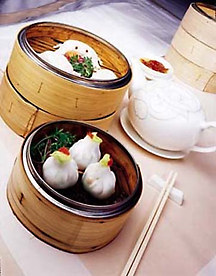 Walk through Chinatown any Sunday and you are likely to see long lines of people forming at popular restaurants for dim sum. More than a meal, dim sum is really a celebration of friends and food. The words can be translated as "little snacks" and the idea is to talk, drink and munch through a seemingly endless variety of tasty tidbits. Dozens of dishes are presented at the table and diners choose the ones they want to eat. The selection can range from ordinary staples of egg rolls, dumplings, and shrimp toast to exotic fare such as lotus leaf wrapped sticky rice, chicken feet and congee which is a hearty rice gruel. Walk through Chinatown any Sunday and you are likely to see long lines of people forming at popular restaurants for dim sum. More than a meal, dim sum is really a celebration of friends and food. The words can be translated as "little snacks" and the idea is to talk, drink and munch through a seemingly endless variety of tasty tidbits. Dozens of dishes are presented at the table and diners choose the ones they want to eat. The selection can range from ordinary staples of egg rolls, dumplings, and shrimp toast to exotic fare such as lotus leaf wrapped sticky rice, chicken feet and congee which is a hearty rice gruel.
Dim Sum is a traditional Sunday family brunch but it is also available around lunchtime at many Chinese restaurants throughout the week. The trick is not to eat too much too soon and to leave plenty of room for dessert.
Desserts seem to get the short end of attention at dim sum. This may be because we are fascinated by the large selection of appetizers and usually end up ordering too many of the turnip cakes, or extra fried squid or other delicacies. However we all know that microwave ovens were invented specifically for reheating Chinese food, so order what you want, and bring what you don't eat home.
Another reasons that desserts don't get noticed is that they are usually on the lower level of the dim sum carts. You have to look to find them but they are worth it. Chinese desserts are not as sweet as European cakes or pies. They are smaller, fitting the dim sum approach that food should be easily munched. Each also tends to focus on one or two basic tastes and textures unlike say, a tiramisu or its British equivalent trifle which are complex arrangements of cake or cookies, jams, flavourings, and cream.
Chinese desserts are simple. First there are the puddings, usually made with a tapioca or cornstarch base. A basic almond flavoured pudding with fresh or canned fruit on top is satisfying and refreshing. Likewise, that blue-ish green wobbly stuff is probably melon flavoured tapioca. The colour may seem a little unusual but the flavour is delicious.
Instead of cakes, opt for sweet steamed dumplings. They are usually bland with a sweet filing: such as a black or red bean paste inside. (Make sure that you ask, since an identical looking dish called Char Siu Bao has barbecued pork inside.)
A variation on the sweet dumpling is Ma T'uan with the dough first filled with sweet paste and fried and then covered with sesame seeds.
Another common dessert, and a typical one to end Chinese banquets, is red bean soup. This is a sweet hot soup made with red azuki beans. I always look forward to the coconut balls. These are gelatinous and about the size of a large golf ball. Equally popular at our table are the egg custard tarts. These usually come three to an order. The custard looks lemony but that is because of yellow food colouring. The filling is a basic milk, sugar and egg custard in a simple pastry shell. This is comfort food, a little sweet and just filling enough to say that the meal is over.
Many restaurants in Chinatown serve excellent dim sums. Line-ups can begin before noon on a Sunday so be prepared to wait. Few restaurants take reservations. You show up, go to the cashier and either say how many people are in your group; or, when the crowd is thick, hold up your hands with your fingers indicating the size of your party. You get a number and wait.
Two popular places are Tong Por at the corner of St. Dominique and de la Gauchetière streets (phone 514-393-9975) and Kam Fung on the second floor at 1111 St. Urbain (phone: 514-878-2888. Kam Fung starts serving dim sum, every day, at 7 AM!
© Barry Lazar 2002  |

|
|